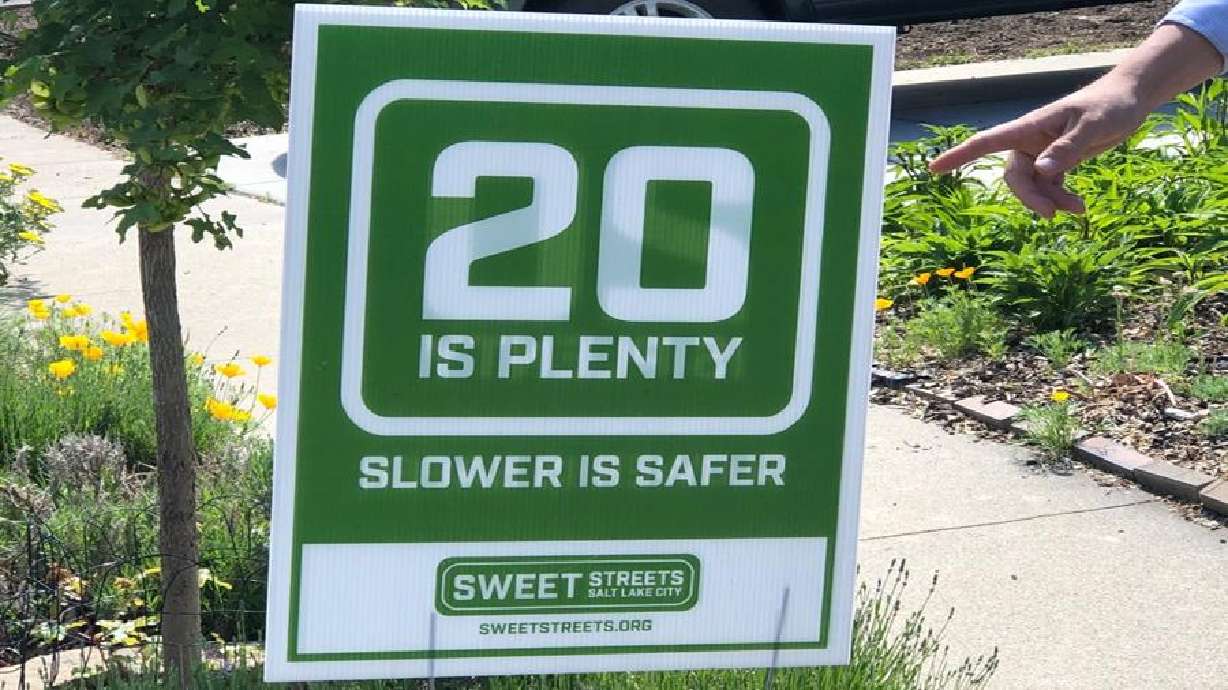Estimated read time: 4-5 minutes
This archived news story is available only for your personal, non-commercial use. Information in the story may be outdated or superseded by additional information. Reading or replaying the story in its archived form does not constitute a republication of the story.
SALT LAKE CITY — The default street speed in Salt Lake City's neighborhoods is one step closer to being reduced.
The Salt Lake City Council, through a unanimous straw poll, gave its transportation division the green light to dive deeper into a proposal to lower the city's default speed limit from 25 mph to 20 mph. If approved in the future, that would apply to all streets in the city unless otherwise posted.
But even the transportation experts who support the idea say lowering the speed limit will likely need future investments to reshape streets.
"(A 20 mph speed limit) would be a bold statement but what would really make a difference ... is backing that up with long-term changes to street design," said Jon Larsen, the transportation division director for Salt Lake City.
The council's decision to have the division look into the issue further was made after three members of the nonprofit organization Sweet Streets provided a presentation on the benefits of reducing the city's default speed limit by 5 mph during the council's work session meeting Thursday.
The volunteer organization began promoting a "20 is Plenty" initiative last year in an effort to reduce vehicle speeds in Salt Lake City's residential neighborhoods. Taylor Anderson, the group's co-founder, explained to the council that safety is the top priority, which is why 20 mph has been generally used in other parts of the world.
When a vehicle reduces its speed from 30 mph to 20 mph, the likelihood a person struck by a vehicle on a street survives increases from 60% to 90%, according to the Utah Department of Transportation. And that's just fatalities. Anderson said people's lives can be "permanently altered" even if they survive those types of collisions.
"It's so important to get those speeds closer to 20 mph. ... There are meaningful safety impacts immediately without redesigning the street just by changing the posted speed," he said during the presentation.
Since traffic safety often lags by years, the organization began keeping track of "traffic violence" in Salt Lake City in late 2020. It's a database of different auto-related incidents reported by news outlets, such as times people were struck by cars and speed-related crashes.
We're asking for a paradigm shift. The way that we set speeds in town right now, it puts the speed of cars first, rather than the safety of the people interacting with the street.
–Taylor Anderson, co-founder of Sweet Streets
They found over a dozen fatalities in the city and a handful of other injuries since December 2020 — and that's only from what was reported by local news outlets. The full number of injuries is likely much more.
Overall, Anderson said people of color, children, elderly individuals and vulnerable populations are disproportionately affected. He concluded his presentation by asking the council to think about people more than car speeds when setting up streets and speed limits.
"We're asking for a paradigm shift," he said. "The way that we set speeds in town right now, it puts the speed of cars first, rather than the safety of the people interacting with the street. By making this change, you have an opportunity to shift that."
It's worth noting the city has started reducing speeds on some streets to 20 mph. These include parts of West Temple and 1300 South. Other streets, like 400 South west of I-15 and 900 West, might be added to the list soon, too.
The default limit isn't universal, though, which Sweet Streets is calling for.
"There's kind of a 1900s-era policy that we're slowly moving away from as an industry," Larsen said. "We're not trying to do everything at once, but just evaluating where appropriate."
While in support of the concept that his division is already looking at, Larsen doesn't believe a speed limit reduction will make much of a difference alone. He views the speed limit as more of a "symbolic" measure and less of a motivator for drivers to slow down.
However, he said it could be a good conversation starter to other tactics to help make streets safer in neighborhoods, including finding ways to shake up street designs that are more "human-centered" like they used to be before motor vehicles. Once the streets look different enough, he said drivers will be encouraged to drive slower.
Anderson agrees. He believes the design of a street, like how wide a street is, lanes and speed bumps all help influence driving speeds more than speed limits do but a limit reduction does at least set an expectation. The organization even held a march last week, which ended with them delivering a petition to Salt Lake City Mayor Erin Mendenhall seeking a redesign of 200 South to include bus-only lanes.
As for the 20 mph proposal, some members of the council said there has to be community buy-in and outreach of any change. For instance, Councilwoman Victoria Petro-Eschler said she is concerned about people who may end up receiving more speeding tickets because they are unaware of a new speed limit.
The idea also has the "full support" of members like Councilwoman Ana Valdemoros.
"I have too many constituents telling me tragic stories and how they would benefit from this," she said.
There was no deadline set for the transportation division's research into the matter. If the division recommends a change, the council will have the final say before it's put in place.










